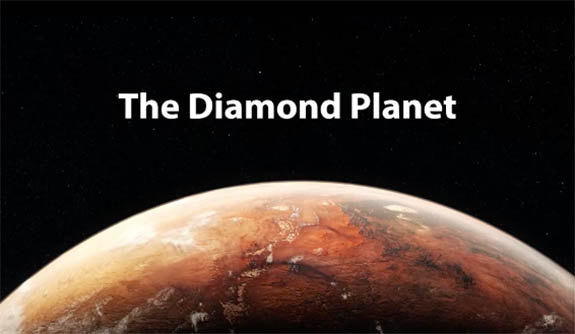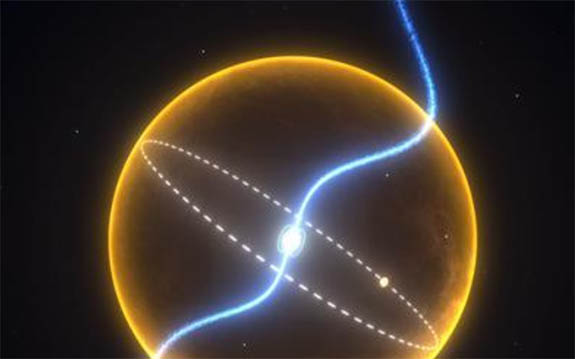May 10th, 2017
Four thousand light years away in the constellation of Serpens, a priceless planet five times the size of our Earth races around a tiny neutron star in an orbit that takes barely 130 minutes. Comprised mainly of carbon and oxygen, the planet is so incredibly dense that astronomers believe that the carbon has taken on a crystalline structure — and that means the entire planet could consist largely of diamond.

The unnamed planet, which scientists describe as the dead core of a once-massive star, orbits a pulsar named PSR J1719-1438. Pulsars are fascinating because these tiny neutron stars spin hundreds of times per second, emitting beams of radiation that can be detected here on Earth. PSR J1719-1438 is just 12.4 miles in diameter, but has a mass that is 1.4 times as much as our Sun.
Matthew Bailes and his team at Swinburne University of Technology in Melbourne, Australia, first reported on the likelihood of a diamond planet in 2011.

"The evolutionary history and amazing density of the planet all suggest it is comprised of carbon -- i.e. a massive diamond orbiting a neutron star every two hours in an orbit so tight it would fit inside our own Sun," said Bailes.
Although the diamond planet is not visible, astronomers can detect it when monitoring the pulsar. Beams from the pulsar are emitted in regular intervals, but are altered due to the gravitational pull of the planet, which is 3,000 times larger than the pulsar.
PSR J1719-1438 and its companion diamond planet are located about one-eighth of the way toward the middle of the Milky Way, which spreads 100,000 light years in diameter.
Although Bailes' diamond planet was the first to make headlines, Yale astrophysicists in 2012 theorized that super-Earth 55 Cancri e was also a diamond planet. Located 40 light years away, the carbon-based super-planet is about two times the size of Earth, eight times more dense and has a surface temperature of 3,900 degrees Fahrenheit.
Credits: Images courtesy of Swinburne Astronomy Productions.

The unnamed planet, which scientists describe as the dead core of a once-massive star, orbits a pulsar named PSR J1719-1438. Pulsars are fascinating because these tiny neutron stars spin hundreds of times per second, emitting beams of radiation that can be detected here on Earth. PSR J1719-1438 is just 12.4 miles in diameter, but has a mass that is 1.4 times as much as our Sun.
Matthew Bailes and his team at Swinburne University of Technology in Melbourne, Australia, first reported on the likelihood of a diamond planet in 2011.

"The evolutionary history and amazing density of the planet all suggest it is comprised of carbon -- i.e. a massive diamond orbiting a neutron star every two hours in an orbit so tight it would fit inside our own Sun," said Bailes.
Although the diamond planet is not visible, astronomers can detect it when monitoring the pulsar. Beams from the pulsar are emitted in regular intervals, but are altered due to the gravitational pull of the planet, which is 3,000 times larger than the pulsar.
PSR J1719-1438 and its companion diamond planet are located about one-eighth of the way toward the middle of the Milky Way, which spreads 100,000 light years in diameter.
Although Bailes' diamond planet was the first to make headlines, Yale astrophysicists in 2012 theorized that super-Earth 55 Cancri e was also a diamond planet. Located 40 light years away, the carbon-based super-planet is about two times the size of Earth, eight times more dense and has a surface temperature of 3,900 degrees Fahrenheit.
Credits: Images courtesy of Swinburne Astronomy Productions.



